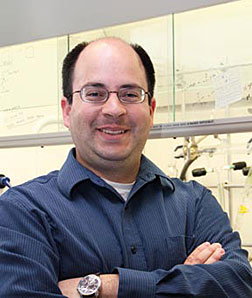- Number 395 |
- August 19, 2013
Ames Lab chemist Vela looks to show viability of photocatalysis for biofuels

Ames Laboratory’s Javier Vela
As a boy growing up in Mexico, Ames Laboratory’s Javier Vela took an early interest in science and planned to become an engineer or a physicist. But an “excellent” high school chemistry teacher helped steer him onto the path to perhaps solving one of the stumbling blocks that’s hampering the biofuels industry.
“My ultimate scientific goal is show the viability of photocatalysis – to convert biomass into fuel using only sunlight as the driving force,” says Vela, who is in his fourth year aa chemist at DOE's Ames Lab. “We’re working to develop catalysts that can harness solar energy and turn it into chemical energy. Basically take water or biomass and turn it into hydrogen or other fuels.”
Vela’s father helped spark his son’s interest in science and technology. A chemical engineer by training, the elder Vela worked “as an IT guy” at the research center of a large power company in Mexico where Javier often visited. Influenced by his high school chemistry teacher and his subsequent participation in Chemistry Olympiad, he majored in chemistry at the Universidad Nacional Autonoma de Mexico in Mexico City where he graduated with honors in 2001.
“I came to the United States for grad school at the University of Rochester where I worked mostly in catalysis and inorganic metallics, and developed an interest in materials,” he says.
That led to postdoctoral appointments at the University of Chicago and Los Alamos National Laboratory. It was a trip between Chicago and New Mexico that gave Vela his first exposure to Iowa.
“My car broke down just outside Iowa City on Thanksgiving Day,” Vela says. “I’d never been in Iowa and had heard it was just corn fields, but the people were great and I had one of the best Thanksgiving dinners I’ve ever had.”
That exposure to Iowa stuck with him and when he began looking for an academic position and to form an independent research group, he gave Iowa State University a serious look.
“Iowa State’s chemistry department had an excellent reputation, and (former chemical and biological sciences program director) Victor Lin was very supportive,” Vela says. “I was also aware of Ames Lab and its strength in materials research from working at Los Alamos. And Ames is a safe, low-stress place to live so it was a great opportunity.”
Vela has been making the most of that opportunity, studying the fabrication, characterization and properties of novel heterostructured nanomaterials, a key tool in developing catalysts to solve the biofuels problem mentioned above. And Ames Lab has been vital in those efforts.
“Ames Lab has obviously been extremely helpful in the scientific area. Electron microscopy is very important to what we do, and the Lab provides us access to those resources,” Vela says.
“A large part of developing new technologies is convincing the public, the taxpayers if you will, that this is actually worth investing in,” Vela adds. “The Lab helps by reaching out to the public, raising awareness and building advocacy. Without that help, we wouldn’t be able to conduct our research at such a high level.”Submitted by DOE's Ames Laboratory
